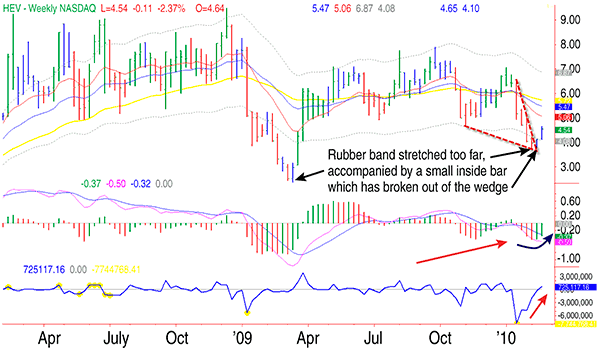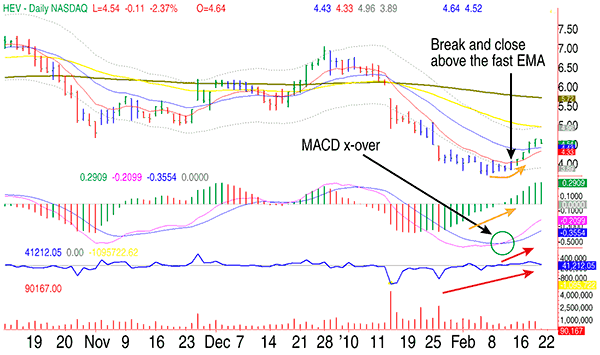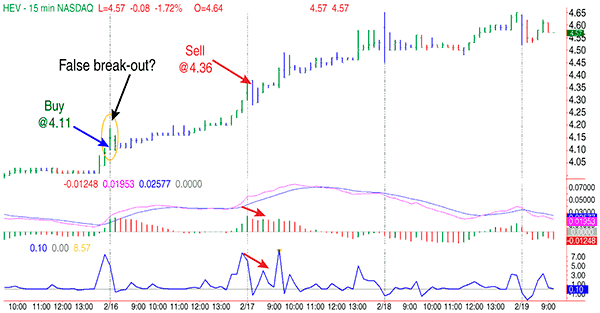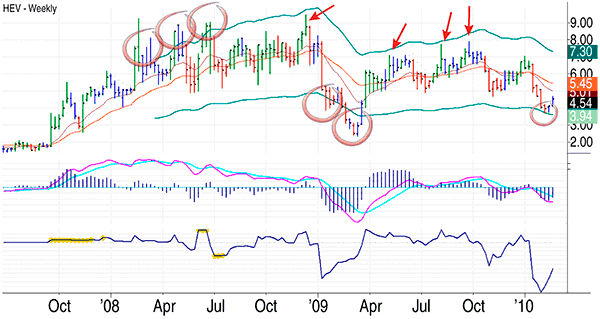
HOT TOPICS LIST
- Strategies
- Stocks
- Buy
- Investing
- Brokers
- Psychology
- Interviews
- Accumulate
- Sell
- Hold
- Spotlight
- Websites
- Candlestick Corner
- Gold & Metals
- Options Trading
LIST OF TOPICS
TRADER'S NOTEBOOK
The Rubber Band Effect
03/31/10 01:32:46 PM PSTby Alexander Elder, MD
SpikeTrade.com is a group of 20 professional and semiprofessional traders involved in a weekly competition. Each member submits his or her pick along with the entry, target, and stop. The picks are submitted in private, and then all is revealed on Sunday afternoon. At the end of each week, the Spiker who wins that week's competition writes up his or her analysis of the trade.
In this article I will review the winning trade from the week ended February 19, 2010. The trader is Stephen M., a serious semiprofessional trader who is also an Idaho-based orthodontist. Steve is the newest Spiker, promoted for his excellent performance as a SpikeTrade member (you can see his profile and the description of his trading style on the website). Here is Steve's analysis of his latest winning trade--AE
| LONG HEV The technical appeal of this trade of Ener1 (HEV) involved four factors (Figure 1):
FIGURE 1: HEV, WEEKLY. A weekly descending wedge resolved to the upside. This caused the impulse system to turn blue as the share price closed back inside the envelope.
|
My trade plan called for the following:
PROGRESS OF TRADE
FIGURE 3: FALSE BREAKOUT? The trade was filled at $4.11 and although it looked like a false breakout could be in the making, a pennant-type consolidation ensued, after which HEV started to climb, taking out the high of the day and finishing strong at the end of the day. A pennant-type consolidation ensued, after which HEV started to climb, taking out the high of the day and finishing strong by the end of the day. HEV shot out of the gate on Wednesday. It jumped up and then momentarily stalled at the slow exponential moving average (EMA). That is where I sold and took my profit, guided by the negative divergence of the force index. |
| That Wednesday, after I sold, HEV reached a high of $4.65. Clearly, I could have and should have held for a much bigger gain. If I could do it over again, I would have tightened my stop as HEV fought the resistance of the 21-day EMA instead of selling the whole position. At worst, I would have given up a little more profit. At best, I could have doubled my return over interest (ROI). I could have sold half at this point and then trailed the stop on the other half. TRADE REVIEW The strategic issue is this: there are two main ways to trade -- value trading and momentum trading. Value traders aim to buy low, sell high. Momentum traders strive to buy high, sell even higher. Most choose between these two strategies "on their gut reaction" -- on the basis of their own instinct and psychological attitudes. Momentum traders tend to be risk seekers, while value traders tend to be more conservative. Steve clearly prefers value trading, and it works for him: He currently leads the Spike group in equity gains. The question for every value trader is how to define value. Steve and I agree that value lives in the zone between two moving averages. When a stock trades above both EMAs, it is above value, and when it trades below them, it is below value. Prices are attached to value as if with a rubber band. When that rubber band becomes overextended, prices are ready to snap back. |
| My favorite method of identifying overextended prices is by using two channel lines, parallel to the slow EMA (see Figure 4). When prices fall below the lower channel line, they mark a buying opportunity. When they rise above the upper channel line, they mark a shorting opportunity. Several occurrences are circled on the chart in Figure 3. Sometimes a rally does not reach the upper channel line; a single bar reaches toward it and then falls away. Several such signals are marked with arrows on the chart.
FIGURE 4: TRADING IS A CONTINUOUS LEARNING PROCESS. The trader exited the trade after seeing a bearish divergence of the force index, which a very minor signal. In spite of the premature exit, it was still a good trade. This shows that trading is a continuous learning process where you constantly try to improve your methods. The tactical question is where and when to take profits in a trade that starts going your way. Steve exited after seeing a bearish divergence of the force index, a very minor signal. He ended up kicking himself for not switching to a trailing stop. This technique is much favored by Kerry Lovvorn, my partner in SpikeTrade.com. Even with a premature exit, Steve bagged the best trade for the group during that week. His self-criticism shows that a successful trader does not rest on his laurels but continues to learn and improve his methods. The SpikeTrade competition runs 52 weeks a year, and in our next article we will review another winning trade. Let's see what lesson we can learn. |
| SUGGESTED READING Elder, Alexander [2010]. "Channel Trade Win," Technical Analysis of STOCKS & COMMODITIES, Volume 28: May. _____ [2010]. "A Gem In The Junk Pile," Technical Analysis of STOCKS & COMMODITIES, Volume 28: Bonus Issue. _____ [2010]. "How I Won My Gold," Technical Analysis of STOCKS & COMMODITIES, Volume 28: January. _____ [2006]. Entries & Exits: Visits To 16 Trading Rooms, John Wiley & Sons. |
Alexander Elder is a professional trader based in New York City. He is the author of Come Into My Trading Room (Barron’s 2002 Book of the Year) and Trading For A Living, considered modern classics among traders. He also wrote Entries & Exits and Sell and Sell Short. He runs SpikeTrade.com with Kerry Lovvorn, a professional trader from Alabama. He may be reached at info@spiketrade.com.
PRINT THIS ARTICLE

|

Request Information From Our Sponsors
- StockCharts.com, Inc.
- Candle Patterns
- Candlestick Charting Explained
- Intermarket Technical Analysis
- John Murphy on Chart Analysis
- John Murphy's Chart Pattern Recognition
- John Murphy's Market Message
- MurphyExplainsMarketAnalysis-Intermarket Analysis
- MurphyExplainsMarketAnalysis-Visual Analysis
- StockCharts.com
- Technical Analysis of the Financial Markets
- The Visual Investor
- VectorVest, Inc.
- Executive Premier Workshop
- One-Day Options Course
- OptionsPro
- Retirement Income Workshop
- Sure-Fire Trading Systems (VectorVest, Inc.)
- Trading as a Business Workshop
- VectorVest 7 EOD
- VectorVest 7 RealTime/IntraDay
- VectorVest AutoTester
- VectorVest Educational Services
- VectorVest OnLine
- VectorVest Options Analyzer
- VectorVest ProGraphics v6.0
- VectorVest ProTrader 7
- VectorVest RealTime Derby Tool
- VectorVest Simulator
- VectorVest Variator
- VectorVest Watchdog




